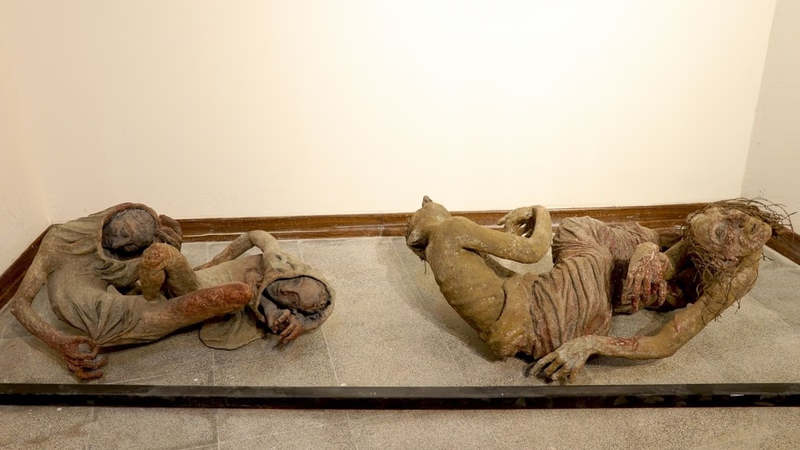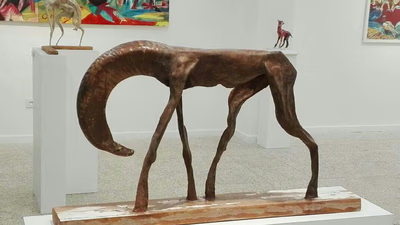
Intricate Middle Eastern sculptures showcase rich cultural heritage.
Sculpting is one of the most important and old crafts in the Middle East , and in this historical region, sculpting techniques and techniques were formed thousands of years ago. Sculpture crafts in the Middle East include stone, wooden, brick, ceramic and metal sculptures, each of which requires special expertise and skills. One of the most admirable features of sculpture in the Middle East is the use of intricate details, geometric designs, and the influence of local literature and mythology. Sculptor artists in the Middle East, using various techniques, have been able to create works that are known technically and aesthetically and are linked to the history and culture of the region. Stone sculptures were used in the Middle East since ancient times and were extracted from local quarries. Among the most famous examples of stone sculptures in the Middle East are Apocalypse statues, Assyrian statues, and Parthenon statues.
In contemporary times, the art of sculpture in the Middle East countries has been affected by social, political and cultural changes. These changes have had various effects on the art of sculpture. In the 19th century and more in the 20th century, the Middle East witnessed the cultural and artistic influences of the West. With the development of cultural and economic relations with Europe, the artists of the Middle East became familiar with the works of art of the West and showed its effects in their works. These influences can include changes in styles, techniques, and subjects. In the contemporary era, some Middle Eastern artists turned to imitation of traditional and conventional works and sought to confront new styles and forms. They sought to innovate in designs, materials, and techniques to create unique and different works.
Wood sculpture also has deep roots in the Middle East and artists use local woods such as cedar, pine, oak and olive. Genealogical, animal and human designs are common in Middle Eastern wooden sculptures and attractive works are created by using cutting, engraving and painting techniques. Metal sculpture crafts also have strong roots in the Middle East and iron, brass, silver and gold are used to create works. Metal sculptures in the Middle East are mostly created in a decorative and textured form, and many geometric, architectural and detailed designs are used in them. In Middle Eastern sculpture, great value is given to the details and industrial quality of the works. Artists in all sculpting handicrafts must have the necessary expertise and technical skills to be able to create valuable and attractive works. Also, works related to the stories, myths and history of the region.
Middle Eastern artists in the contemporary era widely used art to express social, political and cultural issues. Sculpture works were used to express people's attitudes, experiences and struggles. Some of the works of sculpture of the Middle East in this era are known as symbolic and political. With the advancement of technology and the growth of industry in the contemporary era, Middle Eastern artists also used new tools and techniques to create works. This includes the use of new materials and technologies such as steel, aluminum and resin to make sculptures. In contemporary times, Middle Eastern artists used a variety of procedures and styles. They took inspiration from their traditional and local practices and combined them with international practices and styles. This variety and multiplicity of procedures caused the creation of works with various designs and forms.
Visual works (sculpture) of contemporary West Asian artists are definitely comparable to the works of important sculptors from other regions of the world. Art as a universal language, artists from all over the world are influenced and show different cultural and artistic influences in their works. Contemporary West Asian artists, by combining local and contemporary elements, create unique works that can be compared to the works of contemporary sculptors from other regions of the world. They use different techniques and materials and reflect various topics in their works. Through creative and innovative tools, contemporary West Asian artists have been able to create works of high artistic value and diverse aspects.
Regarding the commercial value of visual works of contemporary West Asian artists, it can be said that this value depends on various factors. West Asian contemporary artworks can have commercial value in the world handicrafts market, but this issue depends on factors such as the reputation of the artist, demand and supply, artistic education, innovation and creativity in the works, as well as connection with international markets. With the increasing global awareness of various arts and crafts , the market for contemporary artworks has expanded. West Asian contemporary artists can gain recognition and high commercial value for their works in this global market.
-

Buying and selling art sculptures presents a lucrative opportunity in the modern craft market. Understanding market demands, customer preferences, and pricing strategies is crucial for success. Identifying target customers through market research and events can enhance sales potential. Reliable suppliers are essential; visiting local galleries and art fairs can help find quality artists. Careful examination of sculptures regarding construction quality, materials, and dimensions is vital before purchase. Competitive pricing can be achieved by studying market trends and negotiating with suppliers. Establishing an online presence through websites and social media expands reach to potential buyers. Participation in exhibitions fosters relationships with local customers and businesses.
Effective advertising methods include local media, brochures, and public displays. Superior customer service is key to building long-term relationships, addressing inquiries, and providing after-sales support. Familiarity with regulations such as intellectual property rights and export restrictions is necessary for compliance in the art trade. Collaborating with artists and marketing experts can further enhance business growth while adapting strategies to local market conditions is essential for sustainability.
-

Sculptural art in the Middle East has deep historical roots, showcasing techniques developed over thousands of years. The region"s sculptures, made from stone, wood, metal, and ceramics, are characterized by intricate details and geometric designs influenced by local literature and mythology. Notable examples include ancient stone sculptures like the Apocalypse and Assyrian statues. Contemporary Middle Eastern artists have adapted their work in response to social, political, and cultural changes, often blending traditional styles with Western influences. This evolution has led to innovative designs using various materials such as steel and aluminum. Wood sculpture remains significant, utilizing local woods for detailed carvings that reflect genealogical and animal themes. Metal sculptures emphasize decorative elements with geometric patterns. The value of these artworks is tied to the artist"s reputation and market demand. As global interest in arts grows, West Asian artists are increasingly recognized for their unique contributions to the international art scene.
-

High-quality sculptures and statues require fine details, unique designs, and the use of premium materials to enhance their artistic and commercial value. Identifying target markets is crucial for successful exporting, necessitating research into foreign artistic needs and customer preferences. Effective communication with local agents and distributors can facilitate market entry, while establishing long-term partnerships is essential for navigating trade conditions and export laws. Branding plays a significant role in marketing art; a strong brand identity can differentiate products in a competitive landscape. Marketing strategies such as advertising, public relations, and social media engagement are vital for attracting new customers. Compliance with export regulations is necessary to avoid legal issues, requiring familiarity with each country"s specific laws. Additionally, the design"s dimensions must appeal to buyers, particularly in auction settings. Providing detailed descriptions of sculptures—including materials used and artistic techniques—can enhance buyer interest.
Competing effectively in local markets involves leveraging competitive advantages like pricing, quality, and unique designs. Utilizing technology for online marketing can expand reach to new customers through professional websites and social media platforms. Collaborating with renowned artists can further boost credibility and market presence.
-

The international trade of ancient antique sculptures is a significant and profitable sector, encompassing both legal and illegal markets. Legal transactions typically occur through auctions and exhibitions, where sellers obtain necessary permits to ensure compliance with regulations. These sculptures, made from various materials, hold immense historical and cultural value, reflecting the beliefs and artistic skills of past societies. However, illegal trade poses a threat to cultural heritage, as artifacts are often smuggled and sold on black markets. The value of these antiques can be substantial, influenced by factors such as preservation state and historical significance. The rise of online platforms has transformed the marketplace for antique sculptures, allowing buyers to participate in auctions remotely. International art fairs also serve as venues for showcasing these works. Professionals in the art market play a crucial role in identifying valuable pieces and ensuring their provenance is traceable.
Legal frameworks vary by country regarding the export of antiquities, with many nations enforcing strict laws to protect their cultural heritage from theft and destruction. Compliance with these regulations is essential for preserving history while facilitating legitimate trade.




